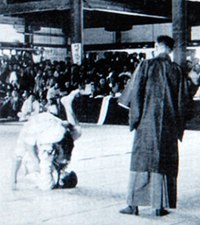Triangle choke
| Triangle choke | |
|---|---|

The triangle choke applied at an early judo tournament.
|
|
| Classification | Chokehold |
| Style | Judo |
| AKA | Sankaku-Jime |
| Parent hold | Guard (grappling) |
A triangle choke, or sankaku-jime (三角絞) in judo, is a type of figure-four chokehold which strangles the opponent by encircling the opponent's neck and one arm with the legs in a configuration similar to the shape of a triangle. The technique is a type of lateral vascular restraint that constricts the blood flow from the carotid arteries to the brain.
The triangle choke was seen in early Kosen judo competition, and Tsunetane Oda, a judo groundwork specialist who practiced in the early 20th century, demonstrated the triangle choke on video. The technique is often used in grappling and mixed martial arts, a notable early example being UFC 4 when Royce Gracie used the choke to defeat Dan Severn to win the tournament. The standard triangle is particularly favored by practitioners of Brazilian jiu-jitsu, however several side or inverted triangles, typically seen more often in Judo competition, have been used in higher-profile MMA matches, such as when Toby Imada won 2009 Submission of the Year with an inverted triangle choke, when Welterweight Chris Lytle submitted Matt Brown with an inverted mounted triangle/straight armbar at UFC 116 in 2010, or in the Flyweight bout of Bellator LXXVII in 2012, when Matthew Lozano submitted Dave Morgan with an inverted triangle choke.McGeary faced Kelly Anundson in the finals at Bellator 124 on 12 September 2014.He won the fight via inverted triangle choke in the first round. It was the first time an inverted triangle was attempted in Bellator MMA, also used by Fabrício Werdum to defeat Fedor Emelianenko at Strikeforce: Fedor vs. Werdum on 26 June 2010, thus ending Emelianenko's 28 unbeaten fight streak.
...
Wikipedia
